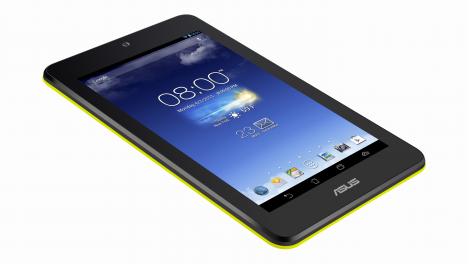
Introduction
By partnering with Google and introducing the world to the original Nexus 7, Asus became a de-facto leader in the small form factor tablet market. At that time, Samsung and Amazon were the only other major players, but backed by Google’s marketing and some incredible pricing, Asus had a game changer on their hands.
In an attempt to dine out on that success, Asus has launched a number of follow-up tablets, clearly utilising its experience with the Nexus 7. The latest of these offerings is the Memo Pad HD 7.
Unlike the company’s previous Memo Pad offering at this size, the HD 7 comes packed with a bevy of excitingly high-end sounding specifications and backs those up with a range of bright, glossy colours, all for a retail price of just £129 ($149, around AU$170).
Comparisons with the original Nexus 7 are inevitable here. The HD 7 is very similar in size, being just a smidge wider and thicker, but gains back the advantage by forcing you to carry a little less heft at just 302g, compared to the 340g of the Nexus 7.

This reduction in weight is despite that minor increase in overall size, with dimensions of 196.8 x 120.6 x 10.8mm.
The similarities don’t end there, as the HD 7 offers a 7-inch screen at the same 1280 x 800 resolution as the original Nexus 7, and also arrives with a quad-core processor and 1GB of RAM.
Despite having similar specifications on paper, the processor is significantly different to the Tegra 3 in the original Nexus 7. It is a MediaTek MTK8125 which is very similar to the MTK6589 that can be found in many Chinese market phones, but it doesn’t contain cellular radios. Indeed, there is no cellular version of the HD 7.
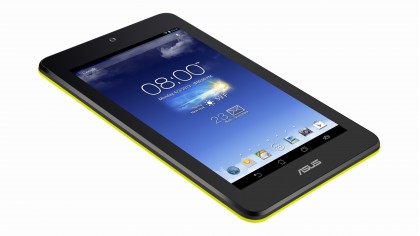
This is a very interesting choice of system from Asus, something it has a history of doing. MediaTek designs its processors to be inexpensive but with good performance and good battery life, and the MTK8125 here is no different: it contains four ARM Cortex A7 cores.
Unlike many other budget tablets, Asus hasn’t skimped on the screen. It has the same resolution as the original Nexus 7, which offers a high 216ppi density, comfortably beating the iPad mini and the Samsung Galaxy Tab 3 7.0 – but it falls down when compared to the 2013 Nexus 7 and iPad mini 2.
This bears out in use, with a nice sharp screen that’s bright and clear. It’s perhaps not quite as good as the best in the business, but it’s a step up on the previous Asus offering with this size screen, the FonePad.
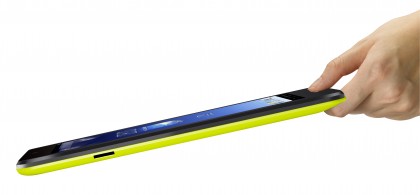
Being an IPS LCD screen, it has fantastic viewing angles. It does suffer from a little more glare than we would like and the colour balance seems a little favoured towards a yellowish tint, but these are minor complaints.
The only real negative is the lack of auto-brightness control, but leaving the brightness at a middle setting is good enough most of the time.
If you have used the original Nexus 7, then holding this latest Asus offering is initially going to feel quite familiar. But after a few moments, some differences become clear, the first of which isn’t positive.

As your fingers run over the back of the tablet, you may feel as I did that the glossy plastics are not of the highest quality, managing to achieve a slightly slimy feel and offering no grip.
To avoid the tablet slipping from my hands I grabbed it by the sides, and in one hand it is just ever so slightly too wide to be comfortable. The original Nexus 7 also had this flaw and the tiny increase in girth here does nothing to help.
Neither does the noticeable seam between the coloured back and the glossy black chamfered edge which gives the impression of a cheap third-party case. It’s certainly not the worst compromise Asus could have made, but the tablet is clearly designed this way to achieve its low price point.
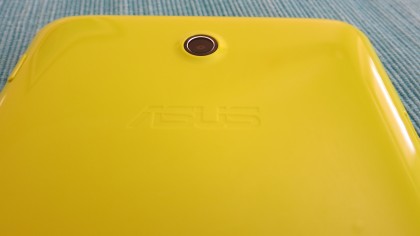
Holding the HD 7 with one hand between thumb and forefingers is a comfortable grip that can be maintained for some time, no doubt due to its relative lightness and weight balance. Spread your fingers out over the back and the neatly etched Asus logo becomes obvious.
The 5MP rear camera is housed in a small bulge, but thankfully the lens is recessed slightly as the tablet rests on the moulded plastic. When using the HD 7 on a flat surface, its curved back can cause the tablet to rock slightly against that bulge.
There is no camera flash. It would be a neater and cleaner design if Asus had been able to make the camera housing flush, as it has on the new Nexus 7.

Above the screen on the front is where Asus has housed the 1.2MP front facing camera. It is very visible but at least it’s centred, unlike on some other Asus devices including the new Nexus 7. Putting an item like that off-centre does nothing for my OCD.
On the left side of the device are the rather excellent buttons, with the one piece volume key sited just below the power button. They don’t have a very responsive feel but they’re easy to find with your fingertips. The buttons are coloured to match the finish of the rest of the rear, blending in nicely.
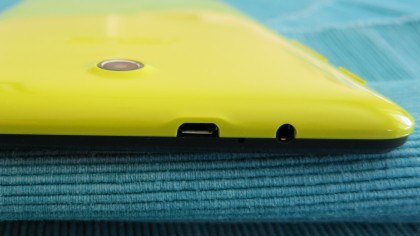
Unusually, the HD 7 has its micro-USB port located on the top of the device next to the standard 3.5mm headphone jack, with the microphone hole sited between these two ports. While it’s uncommon to find the USB port on the top of a tablet of this size, it is ergonomically sound as the HD 7 is simple to use while charging.
The positioning of this port also helps reduce the costs of manufacturing the tablet, as the circuit board has the connection for the port at the top. Asus has avoided running a cable to the bottom of the tablet as it had to on the original Nexus 7.

The HD 7 has 16GB of internal storage, although only around 12GB is available initially. Expandable storage is provided through a microSD card slot on the left side of the tablet and is simply open to the world – I fear it could become filled with dust and dirt.
The card clicks in and is simple to remove, while being held in securely at the same time. Asus also provides 16GB of cloud storage for one year.
Asus has managed to include stereo speakers in the HD 7 despite there being just a single speaker grill. The two physical units are housed behind it and provide some satisfyingly loud output. They do distort quite heavily at high volumes, which is no surprise given just how loud they go.
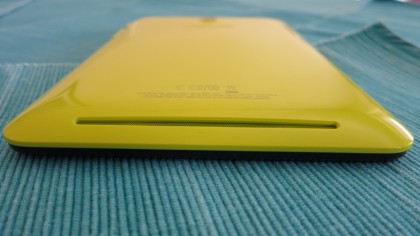
The final piece of the puzzle in the make-up of the HD 7 is the battery. It’s the same basic capacity as in the new Nexus 7 at 15Wh. Asus quotes 10 hours of battery life, which seems a bit optimistic but not entirely unrealistic.
The tablet sips power during extended sleep periods and has a fairly efficient chipset, but the overall battery life falls short of the original Nexus 7, not to mention the iPad mini.
It is however fairly rapid to charge despite the power plug adapter provided in the box not having as high an output as some that are provided with tablets.
Interface
While some Android device makers like to employ fairly hefty customised interfaces on top of the stock Android one, Asus has always taken a more subtle approach and things are no different on the HD 7.
In general, this is something that we applaud, as when it is done well you get the best of both worlds – the excellent stock Android interface and useful enhancements that take it to the next level.

Over the past year, Asus has been refining its enhancements to Android and the HD 7 appears to benefit from its latest thinking, although some of the bells and whistles it provides on its high-end hardware, such as the PadFone Infinity, are not included.
I doubt they will be missed. Obviously, being a tablet, there are none of the customisations that Asus provides for its phones.
The setup process has been completely re-skinned by Asus to a pleasing light grey and takes you through the standard steps of setting up an Android tablet. It’s a quick and painless process that Asus has made a little more attractive. You get your first taste of the Asus keyboard too, but more on that later.
Once the tablet is set up, the first thing to notice is Asus’s customised launcher. The launcher gives you five home screens to play with and add your app icons and widgets to.
There are indicators just above the icon dock at the bottom to show which screen you are on. Talking of that icon dock, it is present on all the home screens.
Home screens can be rearranged, added and removed from a helicopter view, accessed by pinching with two fingers on any home screen.
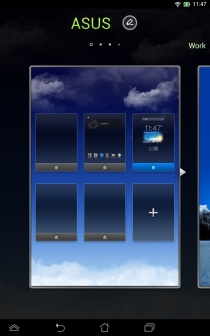
You can also select which is the default home screen and Asus provides a mode where you can have multiple different home screen layouts saved in scenes and the tablet comes with three out of the box. This can be useful if you’re going to use the tablet in different scenarios, but ultimately it has limited benefit.
Asus has always customised the notification drawer, accessed by swiping down from the top of the screen, and the HD 7 is no different.
The company always seems to do a good job with this aspect of its software: on the HD 7 there are a series of customisable toggles at the top of the notification drawer, a brightness slider and shortcuts to Wi-Fi settings, an AudioWizard and wireless display settings as well as a link to the main settings.
This makes the notification drawer take up around a third of the screen even when there are no notifications, but all these enhancements are useful. And if you don’t like what Asus has done here, there’s a setting to toggle back to the standard Android offering.
A number of home screen widgets have been provided with the almost obligatory weather ones being most notable: they are well designed, nice to use and provide a lot of useful information.

The data comes from AccuWeather and the widgets automatically update with your location. Weather is a bit of an obsession for Android widget creators and Asus does it as well as anyone.
The standard Android settings screen has been skinned similarly to the setup process, with a pleasing grey colour scheme. The settings themselves are left largely intact but some have been added.
Power management allows you to control how aggressively the HD 7 manages its power usage by shutting down the Wi-Fi connection whenever possible. I found these tools had limited value and generally offered no genuine savings. Of more interest were the Asus customised settings which included an array of useful tweaks, including controls for the quick settings found in the notification drawer.
Deeper device settings also feature: the Splendid app lets you adjust the colour temperature to your liking and includes a vivid mode that makes colours appear more saturated but does improve the screen for watching video.
The AudioWizard allows you to switch the audio mode depending on what you’re currently listening to.
Parental Lock is probably one of the most interesting features of the HD 7. It allows you to create a PIN code to lock the device. There are two lock levels: system and network.
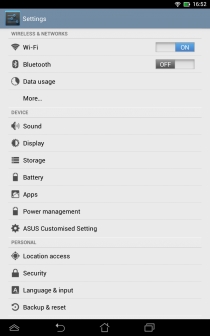
The system lock requires the PIN to unlock the device, but once unlocked it can be used as normal. The device can be used as normal with the network lock, just minus internet access. The latter is obviously useful if you install apps for a child and don’t want them to have access to anything other than those apps.
The system lock level is less obviously useful, since a normal Android PIN lock can also be set. However, there’s more to it as the lock status can also be set remotely on the Asus Device Tracker website. This is quite useful if the device is lost and is genuinely an interesting addition.
The Asus Device Tracker website can also locate your tablet, but it does require you to sign in with either an Asus account or a Google account. The one major flaw in all this is that if you remotely lock the network access, there doesn’t seem to be a way to unlock it as the device cannot connect to the internet to receive the new lock state instructions.
The Asus keyboard sports a simple blue and grey theme and adds a row of numbers to the top in both portrait and landscape orientations. It’s a reasonably good with a fairly accurate predictive text engine at its heart.
When typing, suggested words appear just above the keyboard and you can tap the one you want or press space to complete the word you’re typing with the highlighted suggestion. It supports multiple languages and has a mic button to activate the standard Android speech recognition from the main keyboard. The space bar is somewhat small though.
It also supports trace input where you swipe across the letters that make up a word. Usefully, the stock Android keyboard is also installed and it can be easily selected should the Asus one not be to your liking.
Performance and browser
The way the Asus Memo Pad HD 7 performs befits its budget offering and low price. That’s not to say it performs poorly, but it’s not at the top of the league either. The 1.2GHz quad-core processor churns through tasks at a fair pace but it does feel like something from the past.
Interestingly, it still feels faster than those original Nexus 7’s plagued by well-documented slowdowns after some months of use, and it’s certainly not unpleasant to use.
The animations when swiping between home screens and loading apps show some jitter, but there are no real delays. Apps load fast enough, but the difference in performance between the HD 7 and the new Nexus 7 is noticeable.

Most games play well once loaded as the graphics processing capability of the HD 7 is actually very good, and with the screen resolution a notch down from that full 1080P, there are no issues.
Multi-tasking works as well as you would expect given the 1GB of RAM on board. Switching apps is fast and painless, but there is a low limit on the number of apps that can remain in memory. This isn’t a reason to run a task killer, since Android manages its memory very efficiently.
The only time this lack of RAM can be an issue is if you have many tabs open in a web browser. Switching to a browser tab that’s not in memory will cause the page to reload. Ultimately though, the memory is sufficient for pleasant enough operation.
The screen responds superbly to touches and is very responsive, which turns out to be a double-edged sword. On one hand it means that taps and swipes are detected properly and responded to in a timely fashion. On the other hand it can make the less than buttery animations more obvious. I prefer it to be this way round though, as a poor touchscreen is an extremely frustrating experience.
Browser
As a device mainly designed for media consumption, the web browser will be a heavily used app on the HD 7 and in fact, there are two.

The stock Android browser is on board, although there is no icon for it on the default home screen setup when starting up the tablet. It’s an excellent, minimalist browser with a good layout – you can even side-load the Flash player onto it if you’re so inclined.
Your tabs go across the top with the browser controls just underneath. There’s no full-screen browsing mode so the tabs and controls stay on the display all the time, taking up a little space.
Bookmarks are viewed in a simple grid and the browser history can be accessed alongside them. You can also see your saved pages for later, offline reading from the normal menu in the browser.
Multiple tabs are handled with ease and the tabs area at the top of the browser can be scrolled with your finger to see all the tabs you have open.
Web pages render quickly and accurately. By default, they load at a medium zoom level but this can be changed to an overview or a more zoomed-in lock. Double tapping and pinch-to-zoom work properly, but there’s no text reflow in the stock Android browser. Double tapping on a page of content will zoom to fit the content onto the screen.

Chrome is also provided on the HD 7. As its shortcut icon is on the default home screen, it’s likely to be the web browser most people use. And it is an excellent mobile browser.
When first started, Chrome asks you to connect to your Google account. Then it syncs your bookmarks and browsing history across all your Chrome instances, including if you run it on your mobile phone and desktop.
It too has a simple layout, with tabs along the top and the browser controls just underneath. However, they behave somewhat differently to the stock browser. When scrolling down a page, the tabs and controls disappear to leave you with as much space as possible for viewing the web page.
Bookmarks are again viewed in a simple grid and you can easily access your most visited pages and see your browsing history from other devices.
The performance of Chrome is perhaps even better than with the stock browser. Pages load in a snap – even TechRadar.com, which is a fairly heavy and media-rich page.

As with the stock browser, pages load at a medium zoom level and double tapping or pinch zooming can be used to adjust the zoom level. Again, there’s no text reflow but double tapping to zoom in will show the full web page content.
It’s something of a surprise that Chrome runs so well here, but it seems Google has finally resolved the issues that it has had, leaving us with a top-notch browser that we would definitely use before the stock browser. Part of the speed in both browsers is due to the strong Wi-Fi connection the HD 7 can maintain.
On paper, it offers wireless using the b,g and n standards, with n being the fastest. However, we had some issues getting it to connect to a BT Homehub 4 that supports wireless n. There are no cellular radios on the HD 7 and there’s no LTE or 3G offering either, so it’s Wi-Fi or nothing.
Setting up a Wi-Fi hotspot on a Samsung Galaxy S4 and using the HD 7 through that proved to work seamlessly as well. This is a good performance, notwithstanding the missing wireless n.
Media and camera
Media
Unlike some Android devices, the Asus Memo Pad HD 7 offers a simple range of media and entertainment based around the standard Google Play catalogue.
Unlike on the Nexus 7 and some other tablets, Asus has chosen not to pre-install the Play apps for movies and books, with only the Play Music app being installed from that set. There are no Play Store widgets on the home screen in the default setup either.
It’s a simple matter to install the relevant apps and then you can view the content Google has on offer, either in the Play Store itself or via the Music, Movies, Books and Magazine apps.
Purchasing content of any type is made as simple as possible too, using your details stored in your Google account. Of course, any previously purchased content can also be accessed on the HD 7.
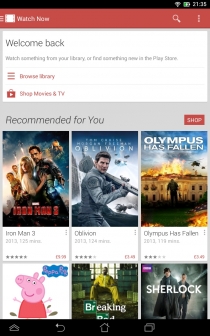
The selection on offer is vast and now includes some TV shows. Generally it’s well priced, but TV shows are an example of content that we consider overpriced. Nonetheless, all the media content can be stored offline and viewed later and the search facilities are simple and effective, as you would expect.
Once you have media downloaded, playing it shows off some nice features of the Memo Pad HD 7. Asus has done a good job making the screen comfortable to read on for extended periods as well as excellent for watching movies.
The speakers are loud and reasonably clear, and actually better than most tablets, which makes listening to music quite enjoyable.
Obviously there’s very little stereo separation and the speakers face away from you, but output is still of a decent quality. Plug in a pair of headphones and audio is fine too. There are higher noise levels than we would like, but the maximum volume is more than enough.
Holding the tablet for extended periods of time to read or watch on isn’t an issue. This is a light and well-sized device. The plastic back lacks some grip, but this isn’t a major complaint.
Alongside the Google stores, other content providers can be used on the HD 7 including Amazon, with its impressive Kindle reading app and massive book shop. At this price, the screen and audio quality of the HD 7 are excellent, making the tablet a good choice for media consumption.
Camera
Taking pictures with a tablet is becoming a more common sight but I would still consider it nothing more than an emergency measure. The HD 7 is too large to hold inconspicuously, but its camera is quite usable. The shots are poor quality, but it’s quick and simple to use, and convenient when you have nothing else to hand.
The interface covers all the bases and is self-explanatory. Taking a picture or starting to record a video can be done from the same interface, so there’s no need to select what type of media you’re capturing first. There are options for different modes such as panoramas, HDR, portraits and so on. You can adjust the effect, including a nice greyscale mode along with manual exposure adjustments. It’s all well implemented and easy to navigate.

Pictures from the rear camera lack detail and tend to be over-saturated, plus they have a fair bit of noise and sometimes appear out of focus. So shots are hardly spectacular, but about what we would expect for a simple camera on a budget tablet.
Videos can be recorded at up to 1080p and come out better than photos, but they still struggle to produce detail and hold focus especially well.
The front-facing camera is adequate for Skype or Google Hangouts calls, but little else. Your selfies are going to be grainy, noisy and basic, while videos can be recorded at 720p, though we wouldn’t recommend bothering as the quality is again poor.
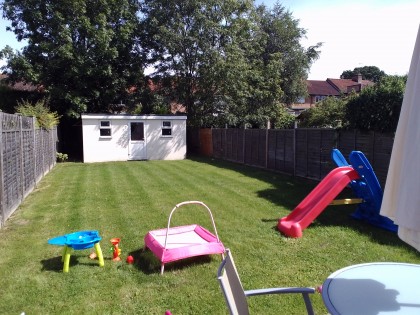
Click here for full resolution image
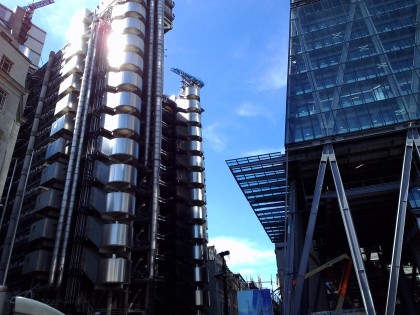
Click here for full resolution image

Click here for full resolution image
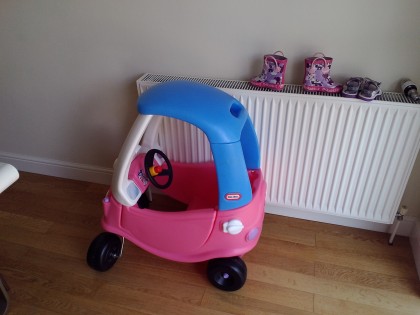
Click here for full resolution image
Apps, battery life and benchmarks
Apps
The Google Play store is now widely stocked, with all the popular apps and games you could want. However there remains a dearth of tablet apps, a space where Google has struggled to engage developers, especially when you compare it to the wealth of high-quality apps made for the iPad.
Seven-inch tablets suffer much less though, as many phone apps still work brilliantly at this smaller tablet screen size. With the popularity of the Nexus 7, many apps have been optimised for this screen size too.
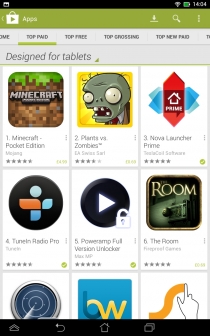
There is a category for tablet apps in the Play Store and all the top pick lists can be viewed as ‘apps designed for tablets’, so things are improving rapidly.
Other app stores are also available for Android devices and the HD 7 is no exception, but in general they offer limited exclusive apps and are often more useful for finding good deals..
Since this is an Android device, all of Google’s apps are available including GMail, Google+ and Google Maps, all of which work well. The one app that doesn’t work well (though it’s not Google’s fault) is Maps Navigation – Google’s satellite navigation solution.
The MediaTek chipset in the HD 7 is well known for having GPS issues and Asus does not seem to have solved them. It took over five minutes to get a GPS lock on the first attempt and around one full minute thereafter.
Using the HD 7 as a sat nav when driving around presents some interesting challenges. The GPS occasionally loses your position. It is usable, but only just. It’s possible this could be fixed in a software update, but it’s hard to know for sure.
Battery life and benchmarking
Despite having a fairly small 15Wh battery capacity, Asus has managed to endow the Memo Pad HD 7 with decent endurance. In constant use, the tablet is easily capable of seven hours’ screen time, which is excellent at the budget end of the market.
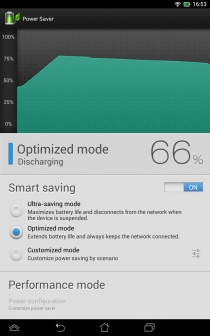
This only tells part of the story however, as there are some serious weaknesses in terms of battery performance. The system should do well in standby, but it doesn’t. The tablet was often out of juice having been left idle overnight, and it seems the Wi-Fi signal is to blame. When used without a wireless connection, idle drain is negligible, but with wireless connected it’s a different story.
Despite their promise, the various power saving modes made very little difference. So overall I got a very mixed picture. But despite its lower capacity battery, it does feel like a tablet you can use all day with few issues.
It makes a good companion on a long haul flight and easily provides enough viewing time for two or three films. Thanks to its standard micro USB port, charging the tablet is easy: it accepts any standard cable and is fast to charge for a tablet. The only slight worry is that charging and using the Memo Pad HD 7 simultaneously does make it get quite hot.
Hands on gallery

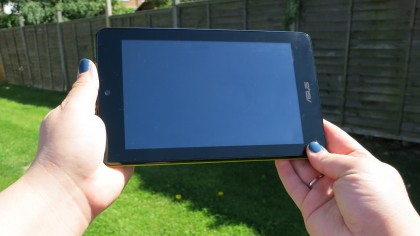






Verdict
There’s nothing outstandingly good about the Asus Memo Pad HD 7, but neither is there anything outstandingly bad. This is a budget tablet that actually exceeds our expectations in many ways. It’s keenly priced and very capable.
We liked
For a device in this market segment, the Memo Pad HD 7 has an excellent screen. It’s sharp and a pleasure to use. As an added bonus, it’s extremely responsive to the touch.
Audio through the built-in speakers and headphones is loud and reasonably clear, making this a great tablet for watching movies on and listening to music.
Asus provides a genuinely useful set of software enhancements on top of Android 4.2.1. The tweaks to the notification drawer are particularly useful.
We disliked
The camera is a pretty poor effort from Asus and it’s questionable whether there’s any value in including it at this price at all. If it took more usable shots, then we would applaud its inclusion, but in its current state, it’s a camera of extremely last resort.
The microSD card slot is awkwardly positioned and we were worried that cards could become lost too easily. While it’s nice to have expandable storage, the HD 7 needs a better implementation.
Material quality on the back of the Memo Pad HD 7 is highly questionable and in some ways unpleasant. Asus has provided some exciting colour choices, but we would prefer a higher quality plain back.
Verdict
As a budget tablet, the Memo Pad HD 7 perfectly fits the bill. It’s fast enough, has all the features you’d expect and a particularly vibrant screen. It’s keenly priced and generally offers an excellent user experience. It’s also light enough to use comfortably for extended periods.
There’s no 3G or 4G version of the HD 7 available, so if accessing the internet on the move is a priority, the Asus FonePad is probably the most viable option, despite its lack of camera and slightly inferior performance and audio/visual quality.
If you already own a small tablet then the HD 7 is unlikely to appeal, but for people dipping their toes into the market for the first time, this is a very credible option.
It won’t cost you that much more for the far superior new Nexus 7, but that price difference represents more than 50% of the price of the HD 7, so Asus has managed to find a niche here, and it has filled it rather well.
![]()










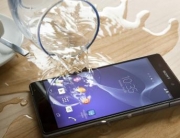

Leave A Comment